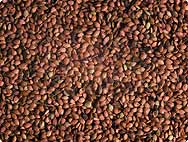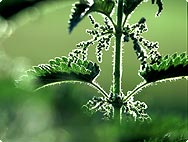
Urtica dioica L.
Greater nettle

History
Nettle is not only a very old plant (evidence of this is provided, among other things, by it’s green blossoms), it has also been used medicinally since the earliest times. Nettle traces were found at the remains of Neolithic stilt dwellings in Switzerland dating back to the third millennium B.C. The term “nettle” is also very old, originating from the Old German term “nezzila”, which in turn is related to the word “net” and refers to an early method of fibre production for the manufacture of untreated cotton. A plant related to the nettle - the ramie - is still an important fibrous plant. The ancient Greeks called the nettle acalyphe. The plant’s Latin name, Urtica, comes from úrere, meaning “to burn”. Dioica means dioecious.The nettle was greatly esteemed by Dioscorides who provided detailed descriptions of its uses. Writing in his “Contrafayt Kreuterbuch” in 1532, doctor and botanist Otto Brunfels commented: “Could there be anything as trifling or as despised as a nettle? What could be as beloved as a hyacinth, a narcissi or a lily - and yet, the nettle surpasses them all.” Lonicerus wrote that the nettle is “hot in the first grade and dry in the second”. The plant is emmenagogic and emollient; it brings relief to flatulence and gravel. It also has diuretic and aphrodisiac properties and can be applied in the treatment of malignant tumours, burns, furuncles, cysts, glandular swellings, dislocations, nosebleeds, splenetic diseases, pleurisy, lung infections, asthma, impetigo, as well as mouth infections and epilepsy. During the 18th century, nettle was effectively applied in cases of dropsy, but it was also used to stem all kinds of haemorrhaging as well as to combat skin rashes. Nettle was also used as a “sympathetic” remedy. One popular method of usage was to flog the body with nettles in cases of rheumatism or loss of muscular power - in spite of the fact that the venom in its sting could cause skin irritation, erythema and even blistering.

Botanical characteristics
Nettle has a creeping, perennial, and highly branched rhizome which produces a stem measuring between 30 –150 cm in spring. This stem is four-cornered; it does not branch out but is covered in short brush-like hairs as well as stinging hairs. These brush-like hairs or down are single-celled and thick-walled, whereas the stinging hairs have a transparent, brittle casing. The tip of the stinging hairs break off easily on contact and pierce the skin, instantly injecting the venomous fluid. The sting can remain in the skin and continue to cause pain or discomfort for between 24-36 hours. The elongated, egg-shaped leaves are heart-shaped or rounded at the juncture between stem and leaf; the edges are roughly serrated and the leaves are arranged alternately along the stem. Every leaf is accompanied by two stipules at the juncture between stem and leaf. As a rule, the flowers bear either male or female blossoms, which means that the Greater Nettle is dioecious. The flowers are inconspicuously greenish in colour and adapted for wind fertilisation. The female flower contains one style with a large, brush-like stigma. The tiny carpel is one-seeded. The male flowers contain four stamens which coil inwards until the moment when flower opens, in which case they right themselves, scattering a tiny cloud of pollen. The plant flowers form July to September. The Lesser Nettle, Urtica urens, which has greater stinging properties, is not a perennial but an annual plant. It grows to a height of just 10 - 40 cm and is monoecious, i.e. the panicles carry both male and female flowers. There are numerous varieties of U. dioica, whereas there is only one known species of U. urens.

Habitat
The stinging nettle is a widespread plant; it can be found all over the world in temperate regions. It is a ruderal plant, which means that it often grows on waste ground or contaminated areas, which it succeeds in ‘decontaminating’. As a nitratophile plant, it grows close to human dwellings, flourishing in particular on soil which has been fertilized or contaminated either by human or animal excrement. It is harder to find the plant in unspoilt or untouched areas of the countryside. Long-derelict manmade camps or dwellings can be recognised by colonies of nettles still growing there. The nettle is regarded as a very good source of iron; on account of its ability to regulate the iron content in the soil it has a positive influence on all plants that grow in the same area - iron being a prerequisite for the formation of chlorophyll needed by all plants. The nettle is a light-sensitive plant; photosynthesis enables it to exist in very different light conditions.
Preparation
A.Vogel/Bioforce uses fresh stinging nettles cultivated in its own organic cultivations to manufacture a mother tincture which is used in A.Vogel’s Stinging Nettle. For the remedy Urticalcin, stinging nettles are chopped finely and combined with ethanol and lactose and gently dried. Phytotherapy makes use of the plant’s leaves, root and seeds. Homeopathic remedies use the Lesser Nettle, Urtica urens, only. There is a German monograph D on the plant. Stinging nettles can also be used as a source of nutrition. Chlorophyll is used to dye tinned foodstuffs such as peas and beans. Nettles are also used in organic farming as a fertilizer, but also as a plant protecting agent and as compost. Dried nettles are a highly useful fodder. Nettles are also used to produce fibre.
A.Vogel Blog – Natural and Healthy
Inspiration for a healthy life!
HERBAMARE SOUP-ER SOUPS!
DOWNLOAD YOUR FREE RECIPE BOOKLET!
8 healthy, hearty and delicious homemade soups.
Supporting a healthier happier you
“Nature is just about the best thing we’ve got!“
Alfred Vogel's guide to leading a healthy and happy life
Healthy & nutritious dinner ideas
Get new recipes in your inbox every month. Sign up now